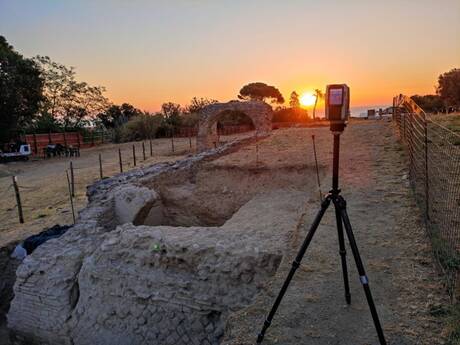CUPRA MARITTIMA - Walls with large squares, where the yellow of the plinth contrasted with the intense red and black of the central band, the solid colors interspersed with delicate decorations of flowers and candelabra, the niches for the statues and perhaps even the very high ceiling illuminated by an intense blue like an August sky.
Yellow and blue, in the temple of Cupra colors like in Pompeii
Built at the dawn of the first century AD
when Augustus reigned over Rome,
the great Roman temple of Cupra, in the Piceno, was in its first phase of life filled with colors and images in the third Pompeian style, with the same colors and the same decorations that at the time they made a fine show of themselves in the richest houses of Rome and Pompeii.
It is the discovery, unexpected and extraordinary - the archaeologist Marco Giglio of the University of Naples
tells ANSA exclusively
- that comes from the archaeological site of the Marche region, where a mission of the
Eastern University
, in collaboration with the
superintendency
and the
municipality of Cupra Marittima
(which manages the Archaeological Park) has undertaken a new research campaign.
"The temples with the interior of the cell decorated with paintings are very rare"
, Giglio points out, "until today only one was known in the III style, that of the Bona Dea in Ostia, where, however, the decorative scheme seems to be much simpler. , in addition to the cryptoporticus of the sanctuary of Urbis Salvia, also in the Marche region, and the Roman temple of Nora, in Sardinia ".
In this corner of the Marche, not far from the sea and a short distance from where the Etruscans in the sixth century.
to C. had successfully managed a sanctuary dedicated to trade, the Romans, says the scientific director of the excavation
Fabrizio Pesando of the Oriental in Naples next to him,
they had settled around the first century.
BC, with a town hall later promoted to the rank of colony.
Inhabited by the families of the armies of Marcantonio and Octavian and their descendants, Cupra, which had taken its name from the divinity of that temple (for the historian Strabo Cupra is another name of Hera) was in those decades a thriving town, with a forum and a large sanctuary of which, unfortunately, very little remains today, but which the excavations conducted by the Neapolitan mission in recent weeks have allowed to somehow reconstruct.
At least in its form and in the two phases of its life, underline Giglio and Pesando.
Because
more or less one hundred years after its foundation, around the first quarter of the second century.
C., the temple revealed serious static problems
that made its radical restoration indispensable, what the Latins indicated as "a fundamentis".
A "demanding and expensive" intervention, explain the archaeologists, carried out with the same advanced techniques that had been used in Pompeii after the earthquake of 62 AD, the one that preceded the fury of Vesuvius by a few years.
For this reason, it is assumed that it could have been the same to finance those works
Adriano, who was born in Spain is true, but descended from a family of Atri, also in the Piceno, and that in 127 d.
C. allowed himself a tour in those parts, even stopping in Cupra.
It was on that occasion, scholars believe today, that the temple lost its magnificent original colors.
Because having to reinforce the walls that contained the cell of the sanctuary, the walls were also chiseled and then in all probability covered with marble, as the fashion of the empire now required.
The marvelous sky blue, as well as the yellows, greens, reds, which had illuminated that sacred space, end up on the ground in a thousand pieces, which the Roman builders, accustomed to recycling everything, will use as the basis for the new floor.
The renovated temple becomes a Corinthian hexastyle
, with the six columns of the front that rise for nine meters, adorned with rich capitals.
But it is also enriched with a series of half-columns in masonry, which are leaning against the side walls, and with amazing lion-headed drips, these too brought to light by the excavation of these days.
A new wonder wanted by Adriano, as an inscription found years ago in nearby Grottammare seems to testify.
While construction sites were buzzing throughout the city and monumental architectures were born, including
the two mighty brick arches,
which still flank the perimeter of the temple today.
Right in front of the stairway still preserved today of the sanctuary, it rose
the base for a commemorative monument, who knows, perhaps a statue of the munificent emperor.
Too bad that in the following centuries - when it is still to be understood - all this beauty is dismantled,
the precious marbles and the imposing columns are reduced to lime to be reused in other buildings
and even the walls of the temple, at the end of the 19th century, were demolished to build a farmhouse whose ruined remains still loom over the ancient staircase of what was once the Roman sanctuary.
"The park is considering whether to restore or remove it," Giglio reports.
All the new finds, meanwhile, have been taken to the restoration laboratories where they will be cleaned and studied.
Excavations will resume in the spring, this time focused both on the two arches and on the rear side of the temple, to shed light on the decoration of its second phase.
Almost two thousand years after that trip of the emperor Hadrian, the Roman Cupra too, little by little, rediscovers its history and its colors.










/cloudfront-eu-central-1.images.arcpublishing.com/prisa/S7ERVSCT4FUVX6R7TUVBDNTH5Y.jpg)



